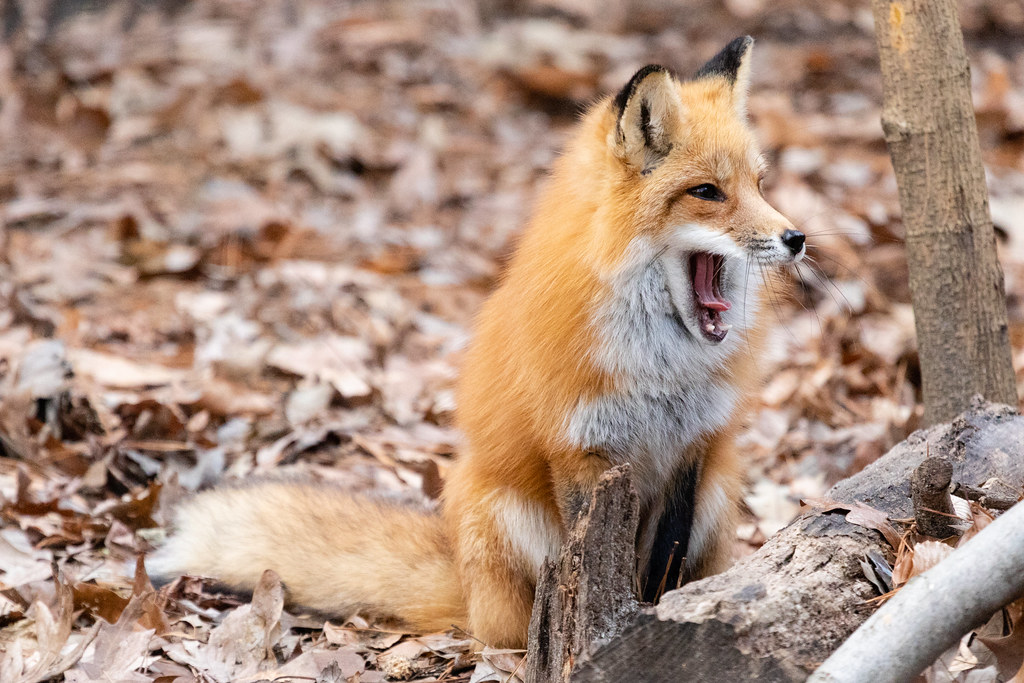Red Fox
Vulpes vulpes
The red fox is a small, reddish, dog-like mammal that lives in swamps, forests and farms throughout the Chesapeake Bay watershed.

Appearance
The red fox varies in color from bright red to rusty or reddish-brown with white underparts. It has black fur on its lower legs and feet and has large ears that are black on the backs. Its muzzle is slim and sharply pointed. A mature red fox has bright yellow eyes. Its bushy red and black tail is usually tipped in white. Red foxes grow to about 25 inches in length and weigh six to 15 pounds. Red foxes can be distinguished from the gray fox by its longer snout, lighter eyes and larger legs and feet.
Feeding
The red fox is an omnivore. It hunts and forages for a variety of foods, including fruits, seeds, worms, insects, small mammals (such as voles, rabbits and muskrats) and small marsh birds and their eggs. It is able to hear small mammals digging, chewing and rustling underground.
Once a fox detects its prey, it digs into the soil to capture it. It will also stalk small mammals by standing very still, then leaping high and bringing its forepaws down to pin the animal to the ground. Red foxes will often store food for later, returning to their hidden supply of food when they are hungry.
Predators
Young red foxes are primarily preyed upon by eagles and coyotes. Mature red foxes can be attacked by larger animals, including bears, wolves and mountain lions. Humans are the most significant predator of adult foxes, who are often hunted for fur or killed because they are considered pests.
Voice
Red foxes have a wide range of vocalizations that are used for different purposes. The most commonly heard red fox vocalizations are a quick series of barks, and a scream-like variation on a howl. Their barks are very high pitched and sound like ow-wow-wow-wow. It is commonly mistaken for an owl hooting.
That bark sequence is thought to be an identification system and studies indicate that foxes can tell each other apart by this call. The scream-like howl is most often heard during the breeding season, in the springtime. It is thought that this call is used by vixens (female foxes) to lure male foxes to them for mating, though males have been found to make this sound occasionally as well.
Most other fox vocalizations are quiet and used for communication between individuals in close proximity. The most unusual is called "gekkering." It is a guttural chattering with occasional yelps and howls, like an ack-ack-ack-ackawoooo-ack-ack-ack.
Gekkering is heard among adults in aggressive encounters (of which there are many; red foxes are highly territorial) and also amongst young kits playing (or play-fighting). They also have an alarm call, which up close sounds like a cough but from afar sounds like a sharp bark, and is mostly used by fox parents to alert youngsters to danger.
Reproduction and Life Cycle
Breeding between red foxes occurs mostly between January and March. Most males have just one female partner, but some males will breed with multiple females. After mating, the female makes a den. The male does not enter the den, but brings food for the female and their pups. It is not uncommon for females who have mated to the same male to share this den.
Gestation lasts 51 to 53 days, after which the female gives birth to a litter of anywhere from one to 13 pups, which are born blind but open their eyes within two weeks. Young red foxes remain in the den for four to five weeks. The female nurses her pups for about two months.
The pups are then given solid food from their parents and other members of their group. Sometimes the female will bring her pups live food to “play” with and eat so they can learn hunting skills. Young remain with their parents until the fall, with some female pups staying longer. The red fox has an average lifespan of three years in the wild; however, it has been reported to live up to 33 years in captivity.
Did You Know?
- While the red fox was originally thought to be introduced from Europe in the 19th century, recent DNA tests have shown that these foxes are indeed native to North America.
- Red foxes are mostly nocturnal, but are also active during dusk and dawn.
- The red fox uses its bushy tail as a blanket to keep warm.
- Red foxes are related to wolves, coyotes and domestic dogs. While their cousins tend to be social animals, red foxes are solitary, cautious and tense.
- Red foxes are fast runners that can reach speeds of nearly 30 miles per hour. Red foxes can also leap more than six feet high.
Sources and Additional Information
- Chesapeake Bay: Nature of the Estuary, A Field Guide by Christopher P. White
- Animal Diversity Web: Vulpes vulpes – University of Michigan Museum of Zoology
- NatureWorks: Red Fox – New Hampshire Public Television
